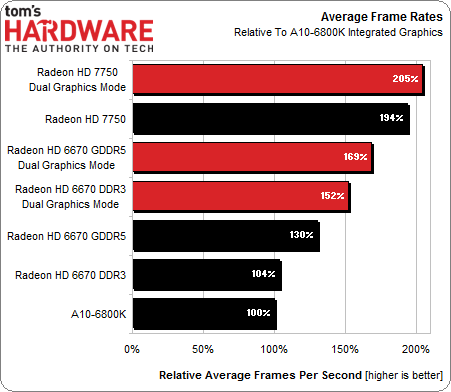AMD Dual Graphics Analysis: Better Benchmarks; Same Experience?
AMD's Dual Graphics technology gives APU owners the ability to add a discrete GPU to their platforms for better performance. We take a close look at the results, both in terms of frames-per-second and experiential smoothness, thanks to captured video.
AMD Dual Graphics: Good For Benchmarks, Not For Gaming
Does adding a discrete graphics card to one of AMD's APUs, enabling Dual Graphics, yield higher frame rates in your favorite games? Sure it does, according to Fraps.
But does it result in smoother gameplay, based on what you see rendered on-screen? After playing around with the feature ourselves, we didn't think so. So, we went about looking for a way to demonstrate. Since FCAT doesn't work due to issues with AMD's driver, we stepped back and used the video we'd normally feed through FCAT instead. And the results aren't pretty for Dual Graphics.
There's a disconnect between the higher frame rates reported in Fraps and the what you actually see when you capture the DVI port's output. This is a feature AMD has been talking about for almost two years now. Dual Graphics should be mature. We're not sure how many mainstream gamers purchased a graphics card to go along with their Llano-, Trinity-, and Richland-based APUs, believing that they'd get a notably better experience, but from what we're seeing, those additional investments are largely going to waste.
Yes, Fraps is telling us that the average frame rates are notably higher. However, this very conundrum was what inspired FCAT in the first place. If the software is counting every dropped and runt frame toward Dual Graphics' average frame rate, then you're getting absolutely no benefit from pieces of frames like the one pictured that are artificially inflating performance.
We're not trying to pick on AMD. Despite knowledge of artifacts like micro-stuttering going back years, isolating experiential data is a more recent phenomenon championed by the team over at The Tech Report, and then further quantified through FCAT, developed by Nvidia. We're very glad that AMD is taking these issues seriously enough that it developed a special driver to help address them. Indeed, we'll be testing the latest Catalyst beta release shortly using the same technique, using it to see if the user experience improves with more consistent frame delivery. Assuming it does, we'll happily dole out the praise to AMD's software team.
With that said, the latest driver doesn't help Dual Graphics. And the problems with this technology are more severe than we imagined even before this story was conceptualized. We're hoping the company gets serious about fixing Dual Graphics, just as it did when it committed to improving CrossFire with two discrete GPUs. Right now it's evangelizing a feature that helps improve benchmark results, but not actual gameplay. That's just not right.
Get Tom's Hardware's best news and in-depth reviews, straight to your inbox.
Current page: AMD Dual Graphics: Good For Benchmarks, Not For Gaming
Prev Page Update: Catalyst 13.8 Beta Driver ResultsDon Woligroski was a former senior hardware editor for Tom's Hardware. He has covered a wide range of PC hardware topics, including CPUs, GPUs, system building, and emerging technologies.
-
beta212 Hmm, IDK, I feel like there is definitely a performance boost in certain games that are just bordering on playability. That said, if you want really good graphics, why not buy the Athlon with disabled GPU cores? Same goes for the intel P series. Just add a discrete card.Reply -
17seconds "That's just not right."Reply
If I had just paid good money for a new graphics card for Dual Graphics, I'd be feeling pretty well cheated out of my money right now. -
joytech22 The drivers tested in this analysis are a tiny bit too old, just before the Crossfire Frame Pacing fix was released.Reply
Could we see this performed again with Catalyst 13.8?
-
cleeve Reply11356019 said:The drivers tested in this analysis are a tiny bit too old, just before the Crossfire Frame Pacing fix was released.
Could we see this performed again with Catalyst 13.8?
See page 2:
"You'll notice that we're using the Catalyst 13.6 Beta 2 driver instead of Catalyst 13.8 Beta, which adds a frame pacing feature for smoother, more consistent output. AMD tells us that the new driver does not affect Dual Graphics configurations. It only works with multiple discrete GPUs. Rest assured that the configuration we're presenting is as up to date as possible."
-
Calculatron Despite the bad news, I think this article was just what a lot of people needed. It helps clears up a lot of confusion and hearsay about AMD Dual Graphics options, like the being able to enable the Radeon HD 7750, or if GDDR5 makes any difference or not. More importantly, it shows how important software optimization is for product performance, and hopefully AMD strives to eliminate similar issues in the future.Reply
As this issue unfolds, I hope there are as informative follow-ups to accompany them. Good job! -
rpgplayer Well, now I see that my Llano box I built for a media center 2 years ago will be completely rebuilt rather than getting an add in card. If AMD's next gen APU will use the FM2+ boards as well I may go that route. If not, I'll probably wind up dumping AMD all together and go with an Intel rig.Reply -
If only AMD spent more of their time and their resources on software optimization rather than on those competition-bashing ads. Seeing some silly ads or reading about some flip/flopping (I now get paid by a different overlord) salesman, bashing Intel or nVidia products, does not instill the confidence in buying AMD products, specifically their APUs and (professional) GPUs. I really do want to buy your stuff AMD; less marketing more software development...pleeease.Reply

